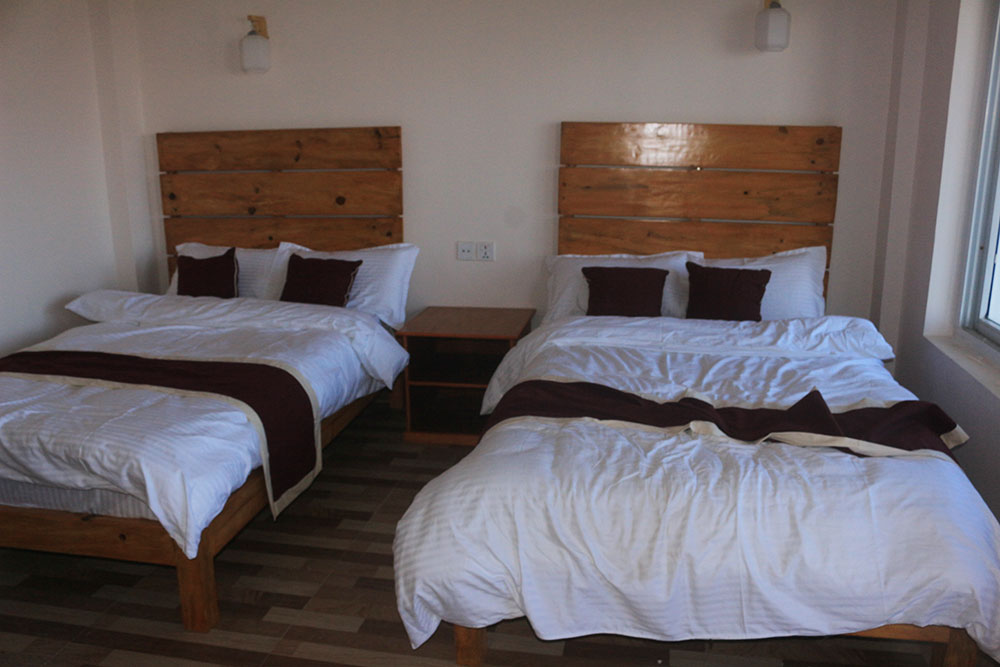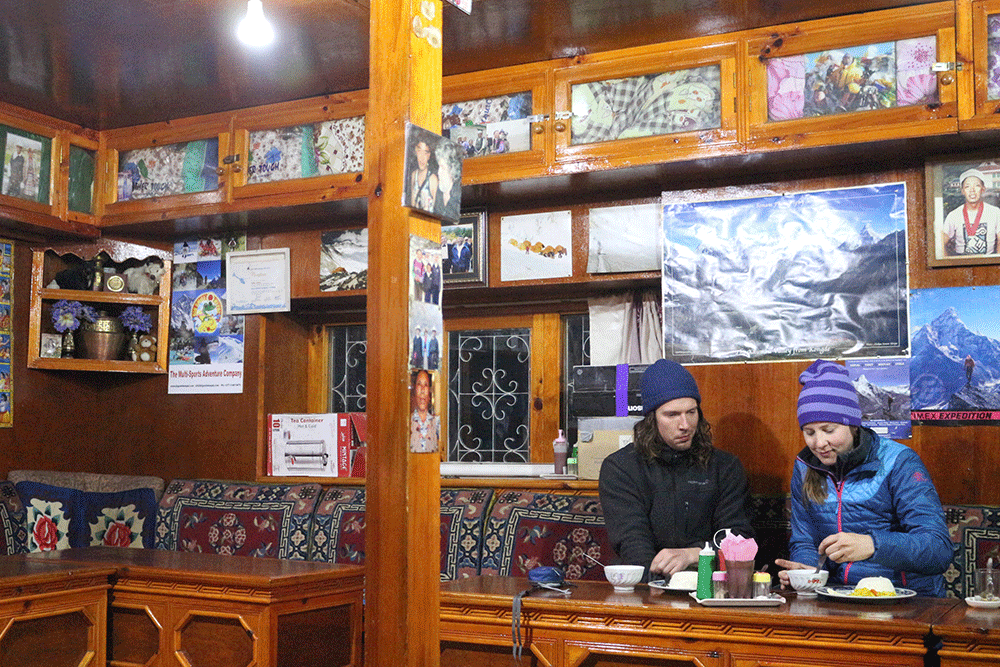
Tea house trekking is a trekking program based on tea houses scattered all along the trekking trails of Nepal.
Tea houses basically refer to mountain lodges operating the bedding and eating facilities for trekkers. Tea houses have recently outnumbered the camping tents as this facility has hugely changed the everyday life of trekkers in terms of comfort, safety and local involvement. Generally, all the tea houses comprise private or sharing bedrooms, indoor toilets, bathrooms, restaurant, a little garden, kitchen and dining room. Most of the tea houses in all trekking trails are owned by local villagers where family members and some extra staff work daily to fulfil the needs of guides, porters and travellers.
Amenities of Tea House
Private bedrooms

Do not get surprised if your tea house located at 4500 meters has rooms with attached toilet, comfortable beds, clean bedsheets and blankets. Tea house rooms are compact with a low ceiling, smaller size beds and little space for lodging your trekking gear but that would be basically enough. Rooms are not insulated but the walls, windows and doors are set in such a way that cold wind at night doesn’t disturb your good night sleep. Room with attached bathroom is a luxury in the mountain region where you are not required to walk out of your room to go to the nearest toilet when it is cold outside. Each room mostly contains two trekkers. Some tea houses have bigger rooms with multiple beds as dorms where maximum 10 trekkers can share the same room.
Kitchen and Dining Room

Mountain kitchens are simple yet elegant on food making. They have to carefully work out on every meal that has been prepared and serve within the given time also. The interesting thing about tea house restaurant is that you can order for a particular time and the food is ready at the expected time. Breakfast is mostly ordered on the day before so that they know what has been prepared for the next morning. Many of the times guides and porters act as waiters as there is not enough restaurant staff to serve food on the table. A dining table is designed according to remoteness and the capacity of guests in the tea house. There is generally some tables with multiple chairs in Everest, Manaslu, Langtang and Poon Hill Treks. Whereas Annapurna Base Camp tea houses have one large dining table with lots of chairs or long desks. In most of the tea houses, there is a traditional firewood oven that insulates the hall. Dried yak dung or firewood is used as fuel.
Toilet, Bathroom and Shower
Toilets in tea houses are simple yet clean with enough water for sanitation. You will have to use your own toilet paper and soap during your treks in the Himalayas. Most of the toilets are Asian style squat toilets while some tea houses are equipped with western style sitting on squat toilets, get prepared beforehand. As far bathrooms, there are bathrooms attached to the rooms or common bathrooms those are shared by multiple trekkers and people are sometimes queued for taking a hot shower. Hot showers generally run with solar power and sometimes with gas or electricity. Depending on the remoteness of tea house and availability of gas shower, you can either get a free hot shower or a paid shower. Recently, the gas shower has replaced solar-powered showers because of unsure weather. That causes no chance to heat the solar panel. Gas showers always require some fees to operate and buying the LPG cylinders. A hot shower generally cost between 2 to 5 dollars.
Electricity, WIFI and gadget charging
Most of the tea houses in Nepali trekking routes are powered by hydroelectricity or solar energy. Remote places with no villages have only solar energy for an electric purpose. There is an electric bulb set in each room so that trekkers do not require a private headlamp moving around in the dark. Power sockets are not available inside the room, hence you have to take your electronic devices to the dining hall where they have multiplies to charge like devices. Most of the tea houses charge like a dollar or two to fully charge a battery.
The modern globalization has been in effect in Nepal’s trekking routes as well. WI-Fi is available in most of the trekking routes of Nepal tea house have WI-Fi is a facility which is helpful for trekkers to stay connected with the world. However, WI-Fi is not free in the mountains. Connecting a mobile device can be charged up to 3 dollars in the mountain and not all the times you are guaranteed with a satisfying browsing speed.
Mini Grocery Store
Besides all the basic facilities required for trekkers, tea house generally run a little shop attached to the tea house building. Most tea houses in Nepal have their own shop designed for trekkers' needs. You can get items such as chocolate bars, cookies, beers, mineral water, juice, cold drinks, toilet paper, chewing gums, woollen clothes, souvenir and basic medical items in the shop.
Do and Do Not for Trekkers While Staying in a Tea House
Please do
Order your dinner before 5 in the evening. Our food can be prepared within an hour or two, depending on the number of guests staying overnight.
Lock your rooms when you are not inside; safety first.
Ask for permission to take photographs with locals.
Order your breakfast before going to sleep.
Make sure that you carry all your belongings from the dining hall to bedroom before you go to sleep.
Remember to return the room keys to the owner before you start your trekking.
Eat all the food in the tea house you are staying; their room charges are generally low and the main business they make is from the food they serve.
Please do not
Leave the tap water running after you have done your cleaning.
Lay your feet on the dining table. It is considered offensive according to local norms.
Wear revealing clothes inside the tea house or on the trekking trail.
Stay very long in the dining hall. The hall can be sometimes used as sleeping rooms for guides and porters. It is suggested to leave the dining hall till 9:00 PM.
Order the dinner when it is too late. Generally, the kitchen closes at 8.30 pm in the evening.
Dry your clothes in the dining hall oversight. If your clothes are lost by the next morning, you will only get upset.
Bargain in room prices. The room prices are fixed by lodge management committee.

